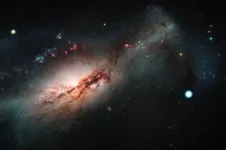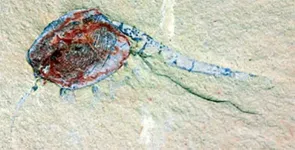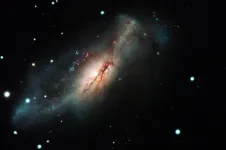(Press-News.org) A worldwide team led by UC Santa Barbara scientists at Las Cumbres Observatory has discovered the first convincing evidence for a new type of stellar explosion -- an electron-capture supernova. While they have been theorized for 40 years, real-world examples have been elusive. They are thought to arise from the explosions of massive super-asymptotic giant branch (SAGB) stars, for which there has also been scant evidence. The discovery, published in Nature Astronomy, also sheds new light on the thousand-year mystery of the supernova from A.D. 1054 that was visible all over the world in the daytime, before eventually becoming the Crab Nebula.
Historically, supernovae have fallen into two main types: thermonuclear and iron-core collapse. A thermonuclear supernova is the explosion of a white dwarf star after it gains matter in a binary star system. These white dwarfs are the dense cores of ash that remain after a low-mass star (one up to about 8 times the mass of the sun) reaches the end of its life. An iron core-collapse supernova occurs when a massive star -- one more than about 10 times the mass of the sun -- runs out of nuclear fuel and its iron core collapses, creating a black hole or neutron star. Between these two main types of supernovae are electron-capture supernovae. These stars stop fusion when their cores are made of oxygen, neon and magnesium; they aren't massive enough to create iron.
While gravity is always trying to crush a star, what keeps most stars from collapsing is either ongoing fusion or, in cores where fusion has stopped, the fact that you can't pack the atoms any tighter. In an electron capture supernova, some of the electrons in the oxygen-neon-magnesium core get smashed into their atomic nuclei in a process called electron capture. This removal of electrons causes the core of the star to buckle under its own weight and collapse, resulting in an electron-capture supernova.
If the star had been slightly heavier, the core elements could have fused to create heavier elements, prolonging its life. So it is a kind of reverse Goldilocks situation: The star isn't light enough to escape its core collapsing, nor is it heavy enough to prolong its life and die later via different means.
That's the theory that was formulated beginning in 1980 by Ken'ichi Nomoto of the University of Tokyo and others. Over the decades, theorists have formulated predictions of what to look for in an electron-capture supernova and their SAGB star progenitors. The stars should have a lot of mass, lose much of it before exploding, and this mass near the dying star should be of an unusual chemical composition. Then the electron-capture supernova should be weak, have little radioactive fallout, and have neutron-rich elements in the core.
The new study is led by Daichi Hiramatsu, a graduate student at UC Santa Barbara and Las Cumbres Observatory (LCO). Hiramatsu is a core member of the Global Supernova Project, a worldwide team of scientists using dozens of telescopes around and above the globe. The team found that the supernova SN 2018zd had many unusual characteristics, some of which were seen for the first time in a supernova.
It helped that the supernova was relatively nearby -- only 31 million light-years away -- in the galaxy NGC 2146. This allowed the team to examine archival images taken by the Hubble Space Telescope prior to the explosion and to detect the likely progenitor star before it exploded. The observations were consistent with another recently identified SAGB star in the Milky Way, but inconsistent with models of red supergiants, the progenitors of normal iron core-collapse supernovae.
The authors looked through all published data on supernovae, and found that while some had a few of the indicators predicted for electron-capture supernovae, only SN 2018zd had all six: an apparent SAGB progenitor, strong pre-supernova mass loss, an unusual stellar chemical composition, a weak explosion, little radioactivity and a neutron-rich core.
"We started by asking 'what's this weirdo?'" Hiramatsu said. "Then we examined every aspect of SN 2018zd and realized that all of them can be explained in the electron-capture scenario."
The new discoveries also illuminate some mysteries of the most famous supernova of the past. In A.D. 1054 a supernova happened in the Milky Way Galaxy that, according to Chinese and Japanese records, was so bright that it could be seen in the daytime for 23 days, and at night for nearly two years. The resulting remnant, the Crab Nebula, has been studied in great detail.
The Crab Nebula was previously the best candidate for an electron-capture supernova, but its status was uncertain partly because the explosion happened nearly a thousand years ago. The new result increases the confidence that the historic SN 1054 was an electron-capture supernova. It also explains why that supernova was relatively bright compared to the models: Its luminosity was probably artificially enhanced by the supernova ejecta colliding with material cast off by the progenitor star as was seen in SN 2018zd.
Ken Nomoto at the Kavli IPMU of the University of Tokyo expressed excitement that his theory had been confirmed. "I am very pleased that the electron-capture supernova was finally discovered, which my colleagues and I predicted to exist and have a connection to the Crab Nebula 40 years ago," he said. "I very much appreciate the great efforts involved in obtaining these observations. This is a wonderful case of the combination of observations and theory."
Hiramatsu added, "It was such a 'Eureka moment' for all of us that we can contribute to closing the 40-year-old theoretical loop, and for me personally because my career in astronomy started when I looked at the stunning pictures of the Universe in the high school library, one of which was the iconic Crab Nebula taken by the Hubble Space Telescope."
"The term Rosetta Stone is used too often as an analogy when we find a new astrophysical object," said Andrew Howell, a staff scientist at Las Cumbres Observatory and adjunct faculty at UCSB, "but in this case I think it is fitting. This supernova is literally helping us decode thousand-year-old records from cultures all over the world. And it is helping us associate one thing we don't fully understand, the Crab Nebula, with another thing we have incredible modern records of, this supernova. In the process it is teaching us about fundamental physics: how some neutron stars get made, how extreme stars live and die, and about how the elements we're made of get created and scattered around the universe." Howell also is the leader of the Global Supernova Project, and lead author Hiramatsu 's Ph.D. advisor.
INFORMATION:
A worldwide team led by scientists at Las Cumbres Observatory has discovered the first convincing evidence for a new type of stellar explosion -- an electron-capture supernova. While they have been theorized for 40 years, real-world examples have been elusive. They are thought to arise from the explosions of massive super-asymptotic giant branch (SAGB) stars, for which there has also been scant evidence. The discovery also sheds new light on the thousand-year mystery of the supernova from A.D. 1054 that was seen all over the world in the daytime, before eventually becoming the Crab Nebula.
Historically, there have been two main supernova types. One is a thermonuclear supernova -- the explosion of a white dwarf star after it gains matter in a binary star system. These white ...
Engineers at MIT and Harvard University have designed a novel face mask that can diagnose the wearer with Covid-19 within about 90 minutes. The masks are embedded with tiny, disposable sensors that can be fitted into other face masks and could also be adapted to detect other viruses.
The sensors are based on freeze-dried cellular machinery that the research team has previously developed for use in paper diagnostics for viruses such as Ebola and Zika. In a new study, the researchers showed that the sensors could be incorporated into not only face masks but also clothing such as lab coats, potentially offering a new way to ...
All life on Earth 500 million years ago lived in the oceans, but scientists know little about how these animals and algae developed. A newly discovered fossil deposit near Kunming, China, may hold the keys to understanding how these organisms laid the foundations for life on land and at sea today, according to an international team of researchers.
The fossil deposit, called the Haiyan Lagerstätte, contains an exceptionally preserved trove of early vertebrates and other rare, soft-bodied organisms, more than 50% of which are in the larval and juvenile stages of development. Dating to the Cambrian geologic period approximately 518 million years ago and providing researchers with ...
The world of microbes living in the human gut can have far-reaching effects on human health. Multiple diseases, including inflammatory bowel disease (IBD), are tied to the balance of these microbes, suggesting that restoring the right balance could help treat disease. Many probiotics -- living yeasts or bacteria -- that are currently on the market have been optimized through evolution in the context of a healthy gut. However, in order to treat complex diseases such as IBD, a probiotic would need to serve many functions, including an ability to turn off inflammation, reverse damage and restore the gut microbiome. Given all of these needs, researchers from Brigham and Women's Hospital have developed a "designer" ...
A new discovery in rats shows that the brain responds differently in immersive virtual reality environments versus the real world. The finding could help scientists understand how the brain brings together sensory information from different sources to create a cohesive picture of the world around us. It could also pave the way for "virtual reality therapy" for learning and memory-related disorders ranging including ADHD, Autism, Alzheimer's disease, epilepsy and depression.
Mayank Mehta, PhD, is the head of W. M. Keck Center for Neurophysics and a professor in the departments of physics, neurology, and electrical and computer engineering at UCLA. His laboratory studies a brain region called the hippocampus, which is a primary driver of learning and memory, ...
An international team of astronomers has observed the first example of a new type of supernova. The discovery, confirming a prediction made four decades ago, could lead to new insights into the life and death of stars. The work is published June 28 in Nature Astronomy.
"One of the main questions in astronomy is to compare how stars evolve and how they die," said Stefano Valenti, professor of physics and astronomy at the University of California, Davis, and a member of the team that discovered and described supernova 2018zd. "There are many links still missing, so this is very exciting."
There ...
NEW YORK, NY (June 28, 2021)--In the first analysis of its kind, researchers at Columbia University Vagelos College of Physicians and Surgeons and several other institutions have linked distinct patterns of genetic mutations with obsessive-compulsive disorder (OCD) in humans.
The work, published online June 28 in Nature Neuroscience, confirms the validity of targeting specific genes to develop new OCD treatments and points toward novel avenues for studying this often debilitating condition.
OCD, which affects 1% to 2% of the population, often runs in families and genes are known to play a large role in determining who develops the disease. However, the identity of many OCD genes remains unknown.
"Many neurological diseases are ...
Slow earthquakes are long-period earthquakes that are not so dangerous alone, but are able to trigger more destructive earthquakes. Their origins lie in tectonic plate boundaries where one plate subsides below another. Though the causal mechanism is already known, there has been a lack of data to accurately model the life cycle of slow earthquakes. For the first time, researchers use deep-sea boreholes to gauge pressures far below the seafloor. They hope data from this and future observations can aid the understanding of earthquake evolution.
The surface of the Earth lies upon gargantuan ...
New York, NY--June 28, 2021--Predicting what someone is about to do next based on their body language comes naturally to humans but not so for computers. When we meet another person, they might greet us with a hello, handshake, or even a fist bump. We may not know which gesture will be used, but we can read the situation and respond appropriately.
In a new study, Columbia Engineering researchers unveil a computer vision technique for giving machines a more intuitive sense for what will happen next by leveraging higher-level associations between people, animals, and objects.
"Our algorithm is a step toward machines being able to make better predictions about human behavior, and ...
Sixteen of the 146 health-related All-Party Parliamentary Groups (APPGs) in the Houses of Parliament (UK) received over a £1 million in payments from 35 pharmaceutical companies between 2012-2018 according to a new study.
The researchers behind the analysis from the University of Bath's Centre for the Analysis of Social Policy suggest their findings reveal a worrying lack of transparency over payments received and potential conflicts of interests towards public policy.
Through their research they extracted details from 6,624 entries about funding ...




